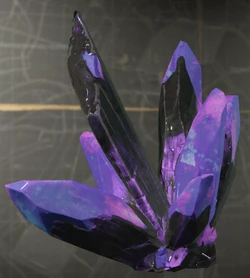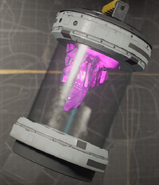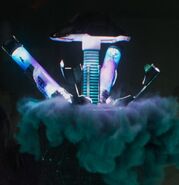- For a similar element, see Element 115.
- For other uses, see Aether.
- "This energy source. The Germans called it "exo-element one." I call it by its proper name...Aetherium. It has the potential to revolutionize the world in ways we cannot possibly comprehend."
- — Oskar Strauss

Aetherium, also known as Exo-Element 1 and Vogelium is an element featured in Call of Duty: Black Ops Cold War, Call of Duty: Vanguard, Call of Duty: Modern Warfare III, and Call of Duty: Black Ops 6 Zombies. It is a highly powerful and equally dangerous element originating from the dimension known as the Dark Aether, from which it gets its name. It is used by military/scientific groups such as Projekt Endstation, Omega Group, Requiem, Project Janus, Operation Deadbolt and Terminus Outcomes for both technological use and for weaponry.
History
Discovery by Projekt Endstation
Aetherium was first discovered by the Nazi scientific group at Morasko, Poland known as Projekt Endstation, specifically by its head, Dr. Ulrich Vogel. On March 16th, 1944, 9 days after an incident involving a particle accelerator that opened a rift to the Dark Aether and turned many of the men into zombies, Vogel was able to isolate the element responsible for their necrotization, dubbing it "Exo-Element 1". Lukas Kurtz, another scientist at Endstation, suggested dubbing it "Vogelium". Through their discovery of Exo-Element 1, Vogel and Projekt Endstation were tasked with weaponizing their findings. Soon, they began working on both a way to control the process of necrotization (as to create an undead army), and weapons utilizing Exo-Element 1 (chiefly, the Decompressive Isotopic Estrangement Machine, which was created from an Exo-Element 1 collector). Endstation also created Exo-Element 1 harvesters that specifically targeted the essence of Tempests, and a conversion machine that could utilize specimens rich in Exo-Element 1 to open a portal to the Dark Aether.
Projekt Endstation's research regarding Exo-Element 1 ended with the undertaking of Operation: Baldr, a contingency plan which sent Nazi forces into the Dark Aether to return at a later date. After Operation: Baldr was completed, the Endstation facility at Morasko became heavily contaminated by Exo-Element 1, due to the rift opened at the site to allow the Nazis to enter the Dark Aether.
Cold War and a New Arms Race
Aetherium, as it would now come to be known, would soon be re-discovered by both the Soviet Omega Group, and the CIA-backed Requiem after the rift to the Dark Aether was re-opened in Morasko. On November 9th, 1983, Omega Group approved "Operation Inversyia", which was dedicated to weaponizing Aetherium and anything else in the Dark Aether in order to win the Cold War. Utilizing an outpost in Vietnam, the Omega Group managed to open their own portal to the Dark Aether, through which they sent "Aethernauts" who specialized in harvesting Aetherium. While this proved to be largely successful in collecting Aetherium (with crystal collection rising to 237%), the excursions into the Dark Aether were still highly dangerous, with a quarter of the Aethernauts never returning. Thus, Dimitri Kuhlklay designed the Red Soldier Mechanized Armor suit to provide protection for the Aethernauts.
On March 14th, 1984, five additional test sites alongside the Vietnamese Outpost 25 were opened throughout the Soviet Union with four of them successfully creating their own breaches. Omega Group were now able to control where and when a dimensional breach would occur with nearly 70% accuracy. On March 19th, Dr. William Peck designed the first teleportation prototype at Outpost 25. Work on weaponizing the process began early April and a missile battery in the Ural Mountains identified as a candidate. On April 8th, Kuhlklay developed the RAI K-84, the first assault rifle powered with Aetherium but was scolded by Peck for wasting their time.
Requiem also developed new technologies using Aetherium samples retrieves from various Outbreak Zones they contained. Carver and his Containment and Security Division developed the Weaponized Aetherium Neutralizer Devices which equipped all their operators in the field. Requiem also planned to thoroughly study the Dark Aether from within Soviet territory in the Ural Mountains and designed several devices for the operation: a Specimen Analyzer station and a Recon Rover conceived by Grey and the Unnatural Science Division on March 13th and April 14th respectively, an Extraction Rocket and an Essence Conversion Module designed by Strauss and the Energy Research Division on April 17th and April 28th respectively as well as a Dimensional Disruptor satellite created by Carver and the Containment and Security Division on March 8th. Requiem also developed an Aetherium Explosive designed to destroy massive Aetherium crystals detected in the Ural Outbreak Zone.
Terminus Island
By February 1991, Aetherium was used in Aetherium Maturation Pods to power the Terminus Island Project Janus bioresearch facility. These pods were created by Project Janus R&D scientists using ideas from Oskar Strauss obtained during his time in detention on the island.
A new outbreak in Urzikstan
In 2021, Victor Zakhaev, with the help of Terminus Outcomes, acquired two vials of Aetherium in a secret room in Zaravan, Urzikstan. The corpses of the ex-Requiem heads were found around the device from which the vials were recovered. He used one of these to trigger an Outbreak in Urzikstan.
During the outbreak, Terminus Outcomes used rockets to extract Aetherium. Operation Deadbolt operators were tasked to destroy these rockets.







